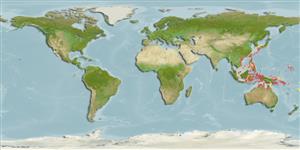>
Perciformes/Serranoidei (Groupers) >
Anthiadidae (Fairy basslets or Streamer basses)
Etymology: Plectranthias: Greek, plektron = anyhting to strike with, spur + Greek, anthias = a fish, Sparus aurata (Ref. 45335).
More on author: Günther.
Environment: milieu / climate zone / depth range / distribution range
Ökologie
seewasser riff-verbunden. Tropical
Western Pacific.
Size / Gewicht / Alter
Maturity: Lm ? range ? - ? cm
Max length : 25.0 cm TL Männchen/unbestimmt; (Ref. )
Max. length (Michael N. Trevor, pers. comm., 1999).
Life cycle and mating behavior
Geschlechtsreife | Fortpflanzung | Ablaichen | Eier | Fecundity | Larven
Randall, J.E., 1980. Revision of the fish genus Plectranthias (Serranidae: Anthiinae) with description of 13 new species. Micronesia 16(1):101-187. (Ref. 8944)
IUCN Rote Liste Status (Ref. 130435: Version 2024-1)
Bedrohung für Menschen
Harmless
Nutzung durch Menschen
Fischereien: kommerziell
Tools
Zusatzinformationen
Download XML
Internet Quellen
Estimates based on models
Preferred temperature (Ref.
123201): 24.4 - 29.3, mean 28.6 °C (based on 924 cells).
Phylogenetic diversity index (Ref.
82804): PD
50 = 0.5000 [Uniqueness, from 0.5 = low to 2.0 = high].
Bayesian length-weight: a=0.01349 (0.00618 - 0.02945), b=3.00 (2.81 - 3.19), in cm total length, based on LWR estimates for this (Sub)family-body shape (Ref.
93245).
Trophic level (Ref.
69278): 4.0 ±0.65 se; based on food items.
Widerstandsfähigkeit (Ref.
120179): mittel, Verdopplung der Population dauert 1,4 - 4,4 Jahre. (Preliminary K or Fecundity.).
Fishing Vulnerability (Ref.
59153): Low vulnerability (15 of 100).
